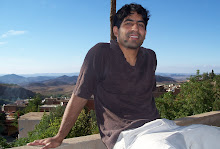 |
| Adwal Coop @ Fes Expo |
 |
| Amina Yabis @ Fes Expo |
As you can imagine, I breathed a huge sigh of relief when the coop was admitted, and I rejoiced with them when they were finally able to leave the cramped confines of their old leased-out workshop for their new and more spacious home. SFIFAM's impact can be truly life-changing for the artisans and the community that supports them. You can read more stories about the SFIFAM impact on their website.
 |
| Ahermoumou Zlul Valley before the winter rains |
 |
| Ahermoumou Zlul Valley after the rains |
Fatima, Hind, and the rest of the cooperative were extremely eager and hungry for opportunities. Luckily, they got an exceptional volunteer named Lynn Dines, who did everything she could to get the word out about the fabulous handmade textile products they were making and to improve the quality of their products. Even after Peace Corps service, Lynn continued to collaborate with the coop.
 |
| Fatima, Lynn, and me @ 2011 Smithsonian Folklike Festival |
So upon hearing that the Adwal Coop would be headed to SFIFAM, I was extremely happy to hear the news. My hope is that with the gains and contacts they've made that they'll be able to continue to expand their business and in turn help more women acquire a trade that will hopefully help them generate more income for themselves and for the home.
Not only will the town benefit economically, but the sale of their products promotes the preservation of their rich cultural Amazigh heritage. Recognition and exposure are what a lot of the artisans need. I am happy that the Adwal Coop was able to get some of that through SFIFAM and through Lynn's efforts. I applaud all of them for their great work. Keep it up and I'll continue to send more baraka all yall's ways!!!
----
Just recently I saw a post on SCORE OC about Fatima and Hind's visit to that great small business resource center. Here's a link to that story if you'd like to learn more about the coop and their post-market travels: http://scoreoc.org/2012/08/03/weaving-success/
*********************************************************************************
----This is a side note deviating from the shout out, but I do have to mention another memory that I have of the town. Ahermoumou has perhaps one of the biggest souqs (open air produce and flee market) in the region. People come from the valley, down from the mountains, and the nearby plains to buy and sell all sorts of goods. Everyone is yelling prices, sheep and goats are bleating, roosters are crowing, chabbi music is blaring, and produce trucks are honking at all times trying to clear a path from the mass of people congregated there. It's hectic to say the least.
The souq itself is pretty impressive, but out of all the commotion, one character stood out. This guy had a piece of plywood sitting on some cinder blocks with a huge pile of peanuts spread out over his makeshift table. What was peculiar was that along with the makeshift table he also had tied a loudspeaker to the top of a wooden pole and had extended the microphone cable to a makeshift headset that he would then use to announce that he had the best peanuts around.
He would broadcast the prices constantly like an auctioneer, every time he made a sale even if it was just a couple of dirham he would announce it, he'd have conversations with his customers on the speaker as well, he would haggle passersby and make wise-cracks publicly, and this went on from early morning until noon nonstop. It was comical to hear the darija word for peanuts repeatedly, kau-kau. He'd be yelling out prices in ryals too: rb3in(40) ryal kau kau, miyat (100) ryal kau kau, kau kau ashreen (20), etc. Basically, every phrase would either start or end with kau kau. The dude was a character. If I happen to visit Ahermoumou again, I will try to see if the peanut vendor is there just so I can be part of his routine once again.












